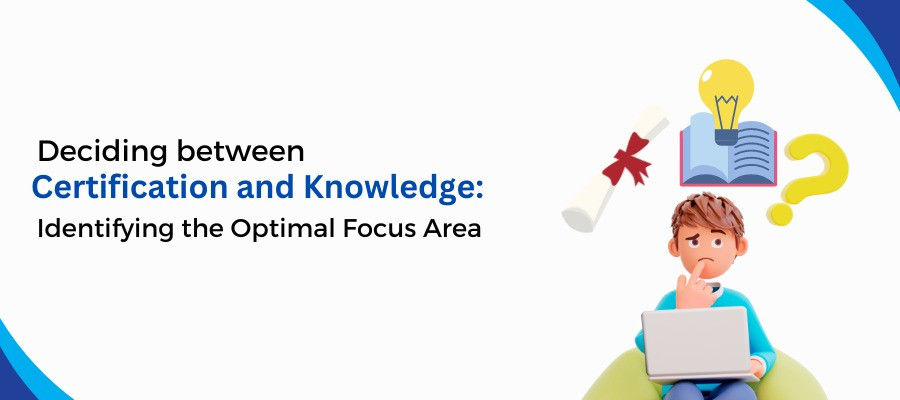Deciding between Certification and Knowledge for SAFe® Identifying the Optimal Focus Area

In today's fast-paced professional world, the quest for career advancement and staying competitive is an ongoing challenge. One key aspect of professional development lies in the decision between obtaining certifications or deepening your knowledge in a specific focus area. Both paths offer unique benefits and contribute to individual growth and success.
This article will explore the importance of certifications and knowledge acquisition, specifically within the Agile and Scaled Agile Framework (SAFe®) fields. We'll delve into the top SAFe® credentials and emphasize the significance of knowledge acquisition in Agile methodologies beyond the well-known Scrum approach. Additionally, we'll analyze the pros and cons of certifications and the value of knowledge in Agile and SAFe®.
Understanding Certifications
Individuals obtain Certifications as official credentials to authenticate their credibility and proficiency in carrying out a particular job. Typically presented as a formal document, your certification signifies that you, as a skilled professional, have undergone training, education, and readiness to fulfill a specific set of requirements for your designated role.
This recognition is exclusively granted upon completing rigorous evaluations conducted by a reputable third-party organization specializing in credentialing.
Top SAFe® Certifications:-
- SAFe® Program Owner/ Program Manager.
- SAFe® Scrum Master.
- SAFe® Advanced Scrum Master.
- SAFe® Practitioner / SAFe® for teams.
- SAFe® Release Train Engineer (SAFe® RTE)
- SAFe® Architect.
- SAFe® Agilist / Leading SAFe®
- SAFe® DevOps Practitioner.
Emphasizing Knowledge Acquisition
Knowledge acquisition involves a deliberate and systematic approach to gathering information from a particular source. This process entails extracting relevant knowledge or data, organizing it in a structured manner, and creating a meaningful representation of the acquired knowledge.
The first step in knowledge acquisition is the extraction of information. This can involve various techniques such as reading, listening, observing, or conducting interviews to gather data from a specific source, such as a document, a person, a database, or even an experience. The goal is to identify and capture the relevant knowledge contained within that source.
Once the information is gathered, the next step is to structure and organize it. This involves categorizing the acquired knowledge, identifying relationships between different pieces of information, and creating a coherent framework or model that represents the underlying concepts and principles.
Analyzing the Pros and Cons of Certifications
- Pros of Scaled Agile Framework (SAFe® ):
Customer-Centric Approach: SAFe® prioritizes a customer-centric approach, focusing on product design, productivity, and fast delivery to achieve product success. It encourages organizations to conduct research and prioritize end-user needs.
Alignment of Organizational Goals: SAFe® addresses the challenge of multifunctional teams working in isolation by promoting seamless collaboration between end-users and agile development teams. This alignment ensures that everyone is working towards common organizational goals.
Increased Employee Engagement: SAFe® has been found to increase employee engagement by 30%. By providing employees with opportunities for mastery and higher goal attainment, SAFe® helps reduce burnout and improve overall employee satisfaction.
Faster Time to Market: SAFe® enables the creation of cross-functional teams that can respond quickly to customer needs, resulting in a shorter time to market. It facilitates speedier decision-making, streamlines operations, improves communication, and enhances focus on delivering value to end-users.
- Cons of Scaled Agile Framework (SAFe® ):
Jargon-Heavy: SAFe® utilizes technical terms such as "Program Increments" and "Release Trains," which can be challenging to remember and comprehend. The extensive use of these terms may create confusion and hinder effective communication.
Top-Down Approach: SAFe® follows a top-down decision-making structure, where the authority rests with top-level managers in the organization. This can lead to some employees or project managers feeling that SAFe® needs to provide them with sufficient decision-making power, making it similar to traditional methods.
Assessing the Value of Knowledge in Agile and SAFe®
Assessing the value of knowledge in Agile and the Scaled Agile Framework (SAFe®) requires a deep understanding of complex methodologies. A profound comprehension of Agile and SAFe® enables organizations and individuals to fully grasp their potential benefits and effectively leverage them for improved performance.
Within Agile and SAFe®, exploring niches that extend beyond the well-known Scrum methodology is crucial. These include methodologies like Kanban, Lean, XP, and others. By getting into these alternative approaches, organizations and individuals gain a broader perspective on Agile practices and discover new techniques to enhance their agility and productivity.
Additionally, understanding the various configurations of the SAFe® framework is vital in assessing its value. SAFe® offers different implementations and adaptations to suit specific organizational needs and contexts. Familiarizing oneself with these configurations enables organizations and individuals to tailor SAFe® to their unique requirements, maximizing its effectiveness.
Finding the Right Balance: Combining Certifications and Knowledge
Striking the perfect balance between certifications and knowledge is essential for working methodology. While certifications demonstrate a certain level of expertise and can open doors to new opportunities, having deep knowledge in a specific field or domain is equally essential for long-term success.
Certifications provide tangible proof of your skills and competence in a particular area, Agile or Scrum. They serve as a recognized validation of your knowledge and can enhance your credibility in the eyes of employers, clients, and colleagues. Certifications also offer a structured learning path, ensuring you acquire standardized skills and knowledge.
However, it is essential to recognize that more than certifications is required. Gaining in-depth knowledge and understanding of a subject matter goes beyond the scope of what certification can offer. It involves continuous learning, staying updated with the latest information, and actively seeking practical experiences.
Conclusion
The decision between certifications and knowledge in Agile and SAFe® should be considered as something other than an either-or choice. Both credentials and deep knowledge are valuable assets in professional development.
Certifications validate skills and expertise, while knowledge acquisition enables individuals to understand the underlying principles and apply them effectively in real-world scenarios.
Reference
- https://www.indeed.com/career-advice/career-development/what-are-certifications
- https://premieragile.com/advantages-and-disadvantages-of-scaled-agile-framework/
- https://medium.com/@shreyashindes1988/the-pros-and-cons-of-the-scaled-agile-framework-safe-4936c18b40c



